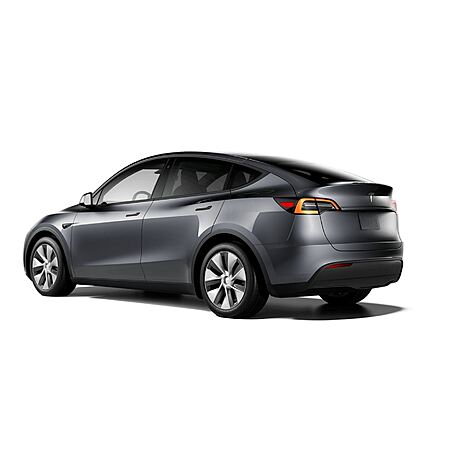https://www.tesla.com/modely/design#overview
Tesla Model Y
Dual Motor
All-Wheel Drive
Range: 330mi
Top Speed: 135 mph
0-60 mph: 4.8 seconds
Qualify for $7500 Federal Tax Credit with below income cap:
Adjusted Gross Income Limitations
$300,000 for married couples filing jointly
$225,000 for heads of households
$150,000 for all other filers
QA Note: List Price Drop
Rear-Wheel Drive is $43,990
Dual Motor AWD Long Range is $48,490 Now $48,990
Extra Discount for already built ones, change to your zip code and check
https://www.tesla.com/inventory/n...&range=100
Please use
the referral link [ts.la] when you purchase one. Thank you!




Leave a Comment
2,286 Comments
Sign up for a Slickdeals account to remove this ad.
1. It was claimed quite a few posts back that instead of pure EV, a PHEV might make more sense, economically. I don't know whether that's true or not but I think it's definitely a good debate to be had.
2. I think given much higher relative price, even after tax credits, one must really be charging at home to make most economic sense instead of superchargers. I don't think that's an outrageous claim to make.
Bottom line though, I'm actually actively considering a Tesla Model Y LR. As a matter of fact I just test drove one again today. To that end I really appreciate real life usage information instead of the all sunshine blow smoke up my rear end ones exhibited from some here, like pretending it's not more expensive, insurance is not more expensive or range and charging speeds isn't a consideration. One can acknowledge there are flaws and weaknesses and still think it's a good car. Tell me the good and the bad.
And I opted to run a 60 amp 240v line 60 ft from basement that cost $1000 for electrician to do permits, material and install, but I get about $800 back between state, utility and federal credits.
Our community has rated this post as helpful. If you agree, why not thank ZaleZ
AMA.
AMA.
Your is the exception not the norm though.
Again, two different sets of fleet sourced data show at 200,000 miles owners average 88% of original range for example- and that's with the earliest, oldest, battery and cooling tech that's been improved multiple times since.
(To be fair the self-presenting door handles on the early S had a LOT of issues-- as did the eMMC.... but they don't use that type of either on the 3 or Y at all, and even the S one has been revised multiple times since then on both items)
Sign up for a Slickdeals account to remove this ad.
Our community has rated this post as helpful. If you agree, why not thank jfk123
NOTE: You can use your income from the year you buy the EV or the previous year-- that's also true in 2023.
The major change for 2024 onward, besides being point of sale, is if your tax liability is LESS than $7500 you still get the full $7500 and get to keep it.
I mean, if you don't consider more than 2 out of 3 people a vast majority, that's on you... because once you include all the non-detached single family homes where they can ALSO charge you're at least to that number- likely higher.
No I'm not.
Unless you think there's some MASSIVE percentage of single family homes that are entirely empty. (there's not)
https://data.census.gov/table/ACSDP1Y2022.DP0
That's the raw data.
61.3% of units are single family detached.
Another 6.2% are single family attached (which frequently have driveways and garages)
Another 5.6% are mobile homes- where again there's typically parking you could plug in a car in front of/next to the home.
We're up to 73.1% of all housing in the US. Even if HALF the single family attached have NO parking, you're still over 70% where home charging is doable.
A few more percent (3.3) are duplexes- where again there's often at least a driveway if not garage to charge in.
Vacancy rates are only 0.8% owner owned and 5.1% rental (and obviously the rentals will slew heavily toward multi-unit for apartments.
So yes, you're talking at least 2 out of every 3 people can charge at home, likely more.
Which seems a pretty vast majority to me.
Please tell me you didn't waste everyones time with these ridiculous replies because you're debating what 'vast' means?
Why?
Is your garage only the exact length, width, and height of your car?
And are there no EXISTING 120v sockets? Because seems that'd be plenty for NYC where you're not driving 100 miles a day around the city and coming back to it anyway unless you're a cab driver (and if you are, there's at least 5 multi-stall Tesla destination chargers in Manhattan- I've seen more than a few Teslas as cabs there and they seem to be doing fine)
You again made a pedantic argument only applicable to your specific case and not the majority of americans?
Yes, I do see!
Right... which is why I mentioned you have to include some NON single family homes in the "can charge at home" stat too, putting it even higher than just the single family ones.
They don't.
For one, the majority of people in NYC don't even own a car anyway.
For another, the folks in say a 5 story walkup with no assigned parking would be in that minority of americans who can't charge at home.
Again, even 30% of the US population is lots of people-- are you planning to individually name the ones who can't charge or something? You're making less and less sense as you go. I never claimed EVERYONE could charge at home... Just most.
Except I'm not because I specifically said most people are at home more than 8 hours.
Do you get home, immediately sleep, then 8 hours later immediately wake up and instantly leave?
No?
Neither does hardly anyone else.
Again you ignored what I actually said and made up a silly strawman.
And are you seriously asking me if my garage is exactly the same length, width and height of my car? No it's not, but I don't know if you actually seen the inside of a garage. Some of the longer cars are already abutting out of the spots. Let's add a couple more inches each. The neighbors must absolutely love you.
You don't have to drive 100 miles a day around NYC. You can, however, absolutely drive more than 24 miles, which is your 8 hour charge. And when you cite plenty of multi-stall chargers in Manhattan, the part you sort of neglected to mention is that they'll charge you $25 parking ON TOP of what you pay at the superchargers. Real economical.
Again, you don't grasp the concept of SINGLE FAMILY HOME AND OWNER OCCUPANCY. Nowhere in your post have you posted that number. Which makes your "vast majority" claim highly laughable.
Did I bring up a silly strawman? Actually I didn't. YOU BROUGHT UP 8 HOUR OVERNIGHT CHARGE. I brought up 3 miles per hour. You're the one that said "so what, they charge overnight and it's good enough for most Americans."
Aside from the fact that, as I've shown with actual data (as opposed to our made up one) that no, it is in fact not enough for most Americans, your example is hilarious in other ways too. It assumes that people can reliably drive 24 or 37 or whatever miles each and everyday without fluctuation. What happens in reality, instead of your made up world, is people go to work, they might decide to go out. They visit family. Kids have soccer practice. There's a snowstorm and people get stuck in traffic burning heating. And yes, New Yorkers might go to Montauk or Connecticut (what a concept, I know). And if they drove to the office the day before but have to use an 120V outlet, they might not, gasp, get there.
And I opted to run a 60 amp 240v line 60 ft from basement that cost $1000 for electrician to do permits, material and install, but I get about $800 back between state, utility and federal credits.
I'm stating that, apples to apples, same level of coverage in liability/injury/etc, a Tesla costs about twice as much as my 2 ICE cars (which to be fair, the first is pretty old, which is why I'm in the market). I can of course get the coverage cheaper by reducing my coverage, but that's hardly the same comparison is it?
I'm still considering one so I'll probably suck up the insurance cost, but let's not pretend it's not more expensive.
I can't understand it for you.
Sorry.
Since that's never been an argument I ever made why would you "challenge" me on it?
Again- strawman.
Again false.
120v overnight is fine for the average miles driven by Americans, so a 120v charger does them fine.
Plus the huge % who CAN install a 240- or already HAVE one via a garage plug with one, or a dryer plug with one, or an oven plug with one.
Again you seem desperate to find SOME kind of argument because you have some arbitrary definition of "vast" for majority and are SURE it disagrees with mine...for...REASONS.
How would mounting a charger on the garage wall higher than the car impact the neighbors? At all?
Are you sure you mean a garage and not a parking lot?
Again people are not generally ONLY home for just 8 hours every day. Another strawman.
I brought up overnight.
You strawmanned it by inserting the 8 hour thing.
Here's me specifically pointing out it's more than 8 from a previous post when you first tried that slight of hand.
Even PRE covid americans spent an average of 50 percent of their waking hours at home... add in the 8 hours they're actually asleep and you get... quite a bit more than 8 hours a day to have the car plugged in.
And that # is even higher now.
So again a fake problem.
Sign up for a Slickdeals account to remove this ad.
Again, two different sets of fleet sourced data show at 200,000 miles owners average 88% of original range for example- and that's with the earliest, oldest, battery and cooling tech that's been improved multiple times since.
(To be fair the self-presenting door handles on the early S had a LOT of issues-- as did the eMMC.... but they don't use that type of either on the 3 or Y at all, and even the S one has been revised multiple times since then on both items)
Leave a Comment